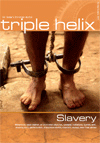Thomas Masterman Winterbottom died in 1859. He was 94 years old – the oldest doctor in Europe. Shops shut. The local Corporation and thousands of citizens turned out to mourn him. In its obituary the Newcastle Journal noted that Winterbottom was 'as good a man as ever was born in the town of South Shields'.[1] What had he done to deserve so much love, respect, and affection?
Today few have heard of him. His magnum opus, two volumes published in 1803, was not republished until 1969. And who, even among specialists in tropical medicine who are familiar with Winterbottom's Sign (of sleeping sickness) know anything about the man himself?
This is a tribute to a great man in this bicentenary year of the abolition of slavery. He was a warm hearted and people-centred Christian, an excellent physician, a fine scientist, and a committed abolitionist who respected women and people of all races.
Sierra Leone
The Sierra Leone Company had been established by abolitionists, with the aim of facilitating trade and 'civilisation' and providing a home for Africans who had been imprisoned under the slave trade.[2] In 1792, having graduated MD from Edinburgh, Thomas Winterbottom sailed for Sierra Leone. He was a man who, unusually for this time, successfully pulled together the Anglican Revival, Enlightenment empiricism, and a burning desire to see the evils of slavery abolished forever.
Winterbottom laboured for four years in the fledgling colony, fighting against malaria (which he contracted several times himself), sleeping sickness, yaws, leprosy, filariasis, tuberculosis, scrofula, scurvy, dysentery, and many other diseases. These often occurred together, making diagnosis almost impossible by eighteenth-century standards. Yet improvements happened very quickly, for Winterbottom records reductions in the high death rate. It is unlikely that the cures of the day achieved very much, but he was not just interested in pathologies, but in what makes for health. He quickly realised that dirty water contained agents of disease and infection.
He observed that good morale was as important to health as the reverse, noting that 'health and [social] harmony' were closely related. He was totally committed to his patients. Even Anna Maria Falconbridge, the caustic and headstrong anti-abolitionist wife of a colleague, is grateful to him.[3] He was also a peacemaker, as his attempts to resolve an emerging quarrel between two of the leading forces in the colony showed. Zachary Macaulay, one of the parties to this disagreement, wrote 'There is so much warmth of affection in him, and the expression of it so often bursts from him involuntarily…'[4]. This was quite a confession, as Macaulay was not known for his spontaneous affection.
Women and polygyny
Winterbottom is notable for his extremely positive view of African women, for rejecting polygyny as belittling women in favour of male status, and for rejecting completely any idea that Africans are of a different race to Europeans. He writes that '…particularly the females, are said to be the handsomest people…The manners of [African women] are [graceful]…estimation of female beauty among the natives…is the same as in most [other countries]…[they] are remarkable for the beautiful contour of their limbs, and for an ingenuous open countenance…'[5].
Regrettably, '[African] women are regarded as beings of an inferior nature, and as born to be the slaves of man…Polygamy …tends still more to debase the female sex …[men rise] in the esteem of [their] neighbours in proportion to the numbers of [their] women.'[6]
Evidence based research
Winterbottom notes how alleged racial differences based on skin colour are absurd, especially when one realises how different skin colour can be within one group. Jewish people, for example, vary from white to black. There are huge variations within African populations.
In Africa he had been aware of what we would now call 'hermeneutical suspicion' and would not accept evidence on the basis of hearsay. On one occasion, he walked 44 miles to see a specific African chief. His interests embraced medicine in the widest sense and he saw it within its social and geographical context. Insects and other fauna interested him. He listed local remedies and cures, as well as noting aversion therapy for dirt-eating, and pioneered vocabularies of West African languages.
Much loved
When he died, Winterbottom had little money, having given much of it away. He never lost his concern for coal miners, sailors and the poor and continued to support charities looking after them. The people of Sierra Leone still remembered him nearly 60 years later. He was a much loved man, ahead of his time, whose writings are still of value to field workers today.
































